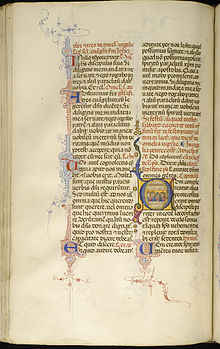
The Roman Breviary (Latin: Breviarium Romanum) is a breviary of the Roman Rite in the Catholic Church. A liturgical book, it contains public or canonical prayers, hymns, the Psalms, readings, and notations for everyday use, especially by bishops, priests, and deacons in the Divine Office (i.e., at the canonical hours, the Christians' daily prayer).
The volume containing the daily hours of Catholic prayer was published as the Breviarium Romanum (Roman Breviary) from its editio princeps in 1568 under Pope Pius V until the reforms of Paul VI (1974), when replaced by the Liturgy of the Hours.
In the course of the Catholic Counter-Reformation, Pope Pius V (r. 1566–1572) imposed the use of the Roman Breviary, mainly based on the Breviarium secundum usum Romanae Curiae, on the Latin Church of the Catholic Church. Exceptions are the Benedictines and Dominicans, who have breviaries of their own,[1] and two surviving local use breviaries:
- the Mozarabic Breviary, once in use throughout all Spain, but now confined to a single foundation at Toledo; it is remarkable for the number and length of its hymns, and for the fact that the majority of its collects are addressed to God the Son;[1]
- the Ambrosian Breviary, now confined to Milan, where it owes its retention to the attachment of the clergy and people to their traditionary usages, which they derive from St Ambrose.[1]
